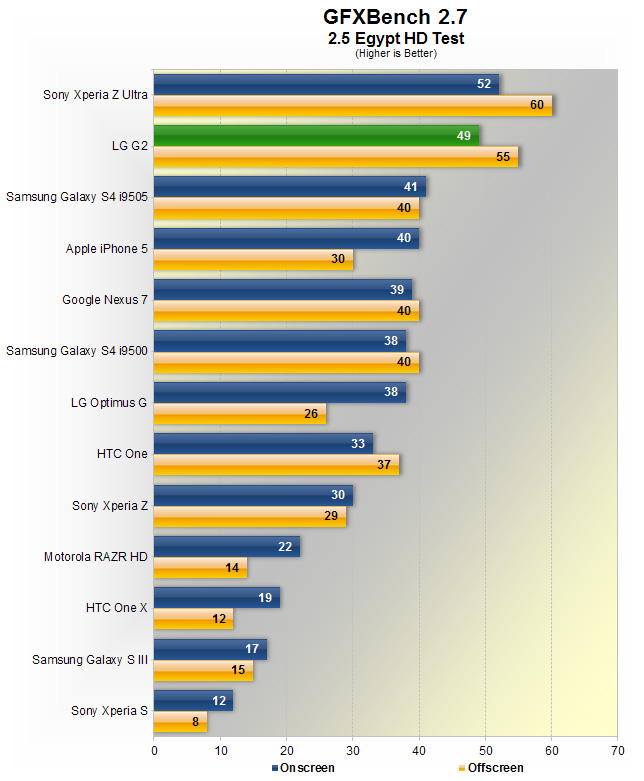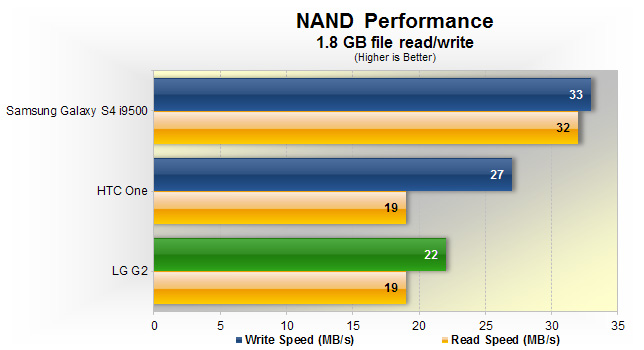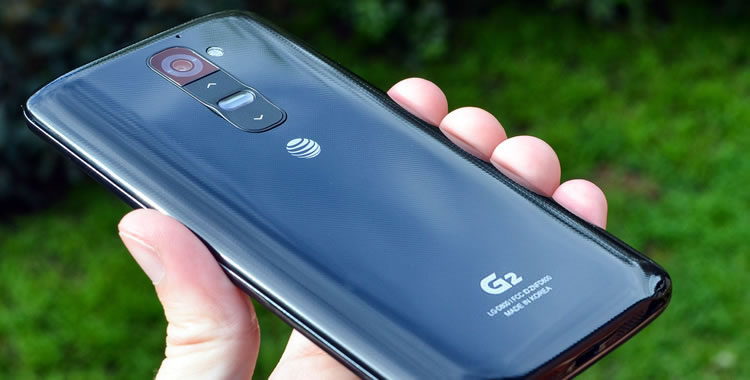Performance: Snapdragon 800 Strikes Again
Internally, the LG G2 is powered by a Qualcomm Snapdragon 800 MSM8974 SoC, which features a 2.3 GHz quad-core Krait 400 CPU, a 450 MHz Adreno 330 GPU, LPDDR3 memory controller, QDSP6V5A Hexagon digital signal processor (DSP) at 600 MHz, and a range of connectivity features including LTE and Wi-Fi 802.11ac.
My first experience with the Snapdragon 800 was in the Sony Xperia Z Ultra, and there's not much difference between the Ultra and the G2 in terms of performance. Both systems feature the Snapdragon 800 with the same clock speed (2.26 GHz), and the same amount of RAM (2 GB), so later on when we get to the benchmarking section, the devices should register the same performance.
When using the device for basic tasks, it's clear that the LG G2 is powered by one of the speediest ARM-based chips you can get. I'm still amazed by just how fast multi-tasking is on this device, with apps resuming and loading in a fraction of a second; faster than I've seen on any non-Snapdragon 800 handset. Swiping through the OS, manipulating high-resolution images, and loading the camera is also blazing fast, making every aspect of this device truly at the touch of a finger.
Web browsing is the fastest I've seen on the G2. You can open up ten tabs, browse between them with ease, pan in and out of element-heavy webpages, and there will be no noticeable hit to system performance. Only when the webpages are laden with images does the G2's browser seem to suffer, which is good news as most websites don't fall into this category, so whether you choose to browse mobile or desktop sites, the G2 has enough speed behind it to power through these tasks.
The G2 is also a suitable gaming device, thanks to its relatively spacious 5.2-inch display, portable body and powerful internals. The Adreno 330 GPU, which is used for the first time in the Snapdragon 800 SoC, is relatively new to the mobile market, and its power has yet to be fully harnessed by game developers. This means any game you throw at the G2 will have no trouble being run fluidly, even intense games such as Grand Theft Auto: Vice City and Real Racing 3.
For what it's worth, the Snapdragon 800's QDSP6V5A DSP and Krait 400 CPU cores are capable of decoding 4K video with very little effort, providing the first fluid 4K video decoding I've seen on a mobile device. Ultra HD content is still relatively rare today, but in the next few years this will be a key aspect of handset performance. Plus, perfect decoding of 4K content means the device has no trouble decoding 1080p videos, and it likely does so at a lower clock speed than less powerful Snapdragon SoCs.
Before we get into the benchmarking section of this review, it's crucial we point out that the LG G2 cheats at benchmarks. By cheating, we mean there is specific code included in the device's OS that sets the CPU clock speed to 2.3 GHz as soon as specific benchmarks are run. The code only affects benchmarks, potentially altering the scores that are output, and providing no 'real world' gains. Out of the benchmarks we run, the LG G2 only tries to cheat in one (Vellamo), so our results shouldn't be altered a great deal.

In Futuremark's Peacekeeper test, which is run in the stock Android browser, the G2 performs on-par with the Xperia Z Ultra (also a Snapdragon 800 device), and comes in 15% faster than the HTC One, a Snapdragon 600 device. It still falls behind the iPhone 5, which is a highly browser-optimized device.


Here we've run Qualcomm's Vellamo benchmark, both in the HTML5 test and, for the first time, the Metal test. Here the G2 is again on par with the Xperia Z Ultra despite the fact it cheats in this benchmark. Compared to the Snapdragon 600 SoC, the G2's Snapdragon 800 is 21% faster in the HTML5 test, and 53% faster at the Metal test. The Metal benchmark tests more aspects of the device, including memory and storage performance, so the G2 might have a more pronounced advantage in these areas.


In GFXBench we ran both the Egypt and T-Rex benchmarks, where the G2's Adreno 330 GPU came in around 50% faster than the Adreno 320. Interestingly, the G2 was 8% slower than the Xperia Z Ultra (which has the same GPU) in the Egypt test, which could be due to different thermal and power restrictions for each device. The Ultra and G2 scored effectively the same in the T-Rex test.

Starting with the LG G2 review we're adding 3DMark to our benchmark cycle, a GPU test focused on 3D rendering and physics. In the Ice Storm Extreme benchmark, the Adreno 330 recorded a 29% performance advantage over the Adreno 320, with the lead extended to 62.5% over the Galaxy S4 i9500's PowerVR SGX544MP3.

With the G2 we've also started to benchmark the internal storage performance of mobile devices, as flash performance can affect the loading times in games, as well as the speeds at which you can copy music, movies and photos to and from the device. Compared to the well-performing Samsung Galaxy S4, the LG G2 carries write speeds of 22 MB/s and read speeds of 19 MB/s, when copying large (1 GB+) files.
Speaking of storage, the G2 comes in two storage variants - 16 GB and 32 GB - which can't be expanded through microSD cards. I have the more abundant 32 GB model with me for review, and with 24 GB of usable space I found the G2's storage to be adequate. Of course I would like for all phones to have expandable storage, but at least this device without a microSD card slot has enough storage for a decent selection of music and a few games.
Another interesting specification that is listed on LG's website is support for 24bit, 192 kHz audio. This is great news for FLAC and lossless audio lovers, although the average MP3 user won't notice any difference. In my testing I found the G2's audio output through the headphone jack to be ordinary, falling behind the fidelity and quality I've experienced on devices such as the Lumia 925 and HTC One. That's not to say the experience is bad, because it's certainly better than some cheapo phones I've used, but it's not quite as good as other flagships I've used recently.
Overall, the LG G2 will provide anyone who buys the device with top-notch performance, thanks to the powerful 2.3 GHz Qualcomm Snapdragon 800 SoC that is more than capable of crushing tasks you throw at it. Even when rendering games at 1920 x 1080, the Adreno 330 is a capable GPU, and the Hexagon DSP alongside dedicated multimedia processors complement the package with low-power audio processing and 4K video decoding.



